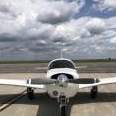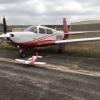Search the Community
Showing results for tags 'brakes'.
-
Hi Everyone. I purchased a 2003 Mooney M20R last April and during the pre-buy, we noticed mushy left brake pedal on the pilot side. The issue was fixed by bleeding the brakes bottom-up and then at every fitting under the belly where small amounts of air bubbled out. Since then the problem slowly got worse and this annual we decided to figure out the root-cause. Here's a list of what we have performed: 1. Identified that Swagelok B-400-7-2 fitting that connects the plastic tubing coming from the reservoir to the T that feeds to the low side of the Pilot master cylinders. Replaced the fitting and the leak stopped. Flushed caliper up and problem persisted. This probably was a problem but not the root-cause. 2. Removed all 4 master cylinders (pilot and co-pilot) and re-sealed them. Although some seals were worn out the inspection before and after revealed no external or internal leaks. We re-sealed anyway. Flushed the system caliper up both sides but the problem persisted. 3. Checked the calipers, lines, fittings and flushed the system reservoir down, caliper up, applied vacuum at the reservoir many-many times. Problem remained. 4. We noticed that the maintenance manual has different bleeding instructions for a/c with pedals on both sides. We blocked the reservoir, pushed fluid up the calipers with a high-flow fitting and cracked open the fittings at the parking brake manifold to see minimal amount of bubbles. I heard from a hangar buddy that when he replaced his a/c's tire, the two parts of the rim didn't fit perfectly because the valve stem could only fit in 1 of 3 positions. This caused the caliper to be pushed back enough during taxi that the first pump pushed the pads close to the disk and the second press held perfectly, unless he was taxiing faster. There are no visible leaks at all and we're kind of lost here. Any help is greatly appreciated. Thanks
-
Hey all! I'm looking for right seat co-pilot brakes parts does someone know anyone that have any? I’m looking to start instruct on my Mooney
-
I changed the seals in the master cylinders of my M20F, put fancy Teflon brake hoses on my brakes and changed the brake pads. After many tries of pressure bleeding from the brake caliper up and from the master cylinders down I still had mushy brakes. I know that there are many more Mooney pilots that have experienced the same problems bleeding their brakes. I consulted some mechanic friends and after some fought after success the brakes work as they should. This is what I found out. I hope it helps you avoid the immense frustration of bleeding Mooney brakes. Note: My aircraft does not have brakes on the copilot side. The brake line comes from the reservoir to a T above the master cylinders then to each respective master cylinder and then downward toward the brake calipers. If each side is bled individually, an air bubble can shuttle at the T and not bleed out. Air can also hide in the master cylinders. After consulting the maintenance manual and some Mooney mechanics who agreed that it was at times extremely frustrating to bleed Mooney brakes, more that one offered this advice. "If you pressure bleed from both the calipers up to the reservoir at the same time and jiggle the tops of the brake pedals during the process you have a very good chance of eliminating all of the air in system." You can purchase 1/4 inch clear plastic tubing from many hardware stores along with a T fitting so that you can bleed both brakes at the same time with one pressure vessel. If you have any other sure fire techniques for bleeding the brakes I am all ears but this one works great. PS Remember to run a clear plastic line from the top vent on the reservoir to an empty brake fluid can so you can keep an eye on the bubbles and avoid getting overfilled fluid on the cockpit floorboard. I will attach photos of the process later.
-
Hi all, I am looking for the kit to add passenger side brakes for my 1982 J. Thanks for any help! Mike
-
Could do with a bit of wisdom for the community here. Just come out of Annual, where I got new brake pads, but one calliper had to come off to clean up and replace the seals, and the master cylinder got new seals at the same time. My A&P spent several hours with a pressure bottle forcing fluid up from the bottom, but the results weren't great. I helped him pump stuff down from the inside using the pedals whilst he operated the bleed screw, and it was still no better. We went back to the pressure bottle and forced another gallon through the system, and got a few more bubbles to show in the reservoir return line, but the action is still far from good. Has anyone got a good method for purging all the air out of the lines? We are considering making an adapter up for the bleed nipple so as to be able to push a higher flow, but so far this is driving us crazy! Another through is to do this on jacks so the flow from the master cylinders to the reservoir isn't 'downhill', but it seems like a long shot TIA Ben
- 19 replies
-
- Brakes
- brake fluid
-
(and 2 more)
Tagged with:
-
I am looking for an paramount master cylinder so that I can make (owner supplied part) the brass internal check valve with a new o-ring. A non serviceable cylinder would be great. I will likely need to destroy the part to copy it.
-
- brakes
- 850012-501
-
(and 1 more)
Tagged with:
-
Looking for recommendations on brake parts: Cleveland or Rapco? Need to order today for tomorrow deliver?
-
Hello, Does anyone have any suggestions how I can tell what brakes my 1965 M20E Super 21 has. I normally order everything from LASAR but they are closed until January 2nd. I would like to order from Aircraft Spruce but they are asking brake system type (example-Clevland brakes). I need linings, rivits, and caliper O-rings-rebuild kits. I would like to order the parts on 12/23/13. Any help would be greatly appreciated. Thanks, Mitch
-
Tthe left brake pedal in my 231 lost all hydraulic fluid. There was evidence that fluid had leaked past the piston o-ring in the brake assy. I am replacing the o-ring and I am back bleeding the brake system through wheel cylinder bleeder valves using pressure pot. Using this method is there a need for pumping the brake pedals? Service manual states that the brake pedal should be "pulled back" (section 12-20-05). Any helpful suggestions out there from folks that have experience with brake bleeding mooneys. Does raising nose wheel off the ground help? What will be indication that the master cylinder needs servicing? Thanking you in advance for your help. peter lamberty N322DB








